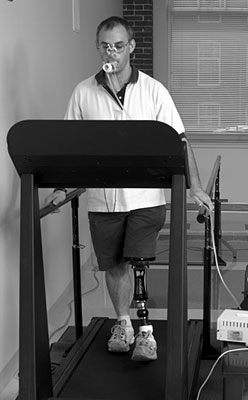Dartmouth expertise leads to a new way to attach limbs
It's irritating when your shoes that fit so comfortably in the morning are unbearably tight by nightfall. But it's downright embarrassing when your artificial leg falls off as you're getting out of your car, or riding your bike, or just walking up the street.
What?! That's right. Getting a perfect fit for an artificial leg can be tricky: what feels right in the prosthetist's office may not feel so great later on. That's because the residual limb—which used to be called the stump—can shrink and swell during the day and interfere with how a suction- fitted limb stays attached.
Leg: Dartmouth orthopedic surgeon Michael Mayor, M.D., is all too familiar with that problem. He lost a leg to cancer at age 17 and has been getting around on an artificial one since the 1960s. Pretty soon he'll be helping to test a new kind of artificial leg, one developed with his input by Simbex, a Lebanon, N.H.-based R&D firm.

|
|
This research participant is trying out the new Simbex limb on a treadmill. |
A contraction of "Simply Better Exercise," Simbex is one of several high-tech companies founded by fluids engineer Robert Dean, Sc.D., an adjunct professor of engineering at Dartmouth. Dean has an artificial leg, too. He lost his real one some 60 years ago "in a crawler tractor— it ate my leg up through the knee joint," he says.
Until the early 1990s, Dean's artificial leg—an older model held in place with straps—fit fine. But then he lost 40 pounds while recuperating from what he describes as a "near-fatal heart attack." He replaced his old leg with a modern one equipped with a fiberglass socket that fits on the stump, like a thimble on a finger, and is held in place by suction. But Dean could not get his new leg to fit all day long.
"Tissue dynamics are complex," explains orthopedist Mayor. The socket can knead the residual limb, forcing fluid out. As that happens, the limb shrinks. On the other hand, the weight of the artificial limb can "produce a vacuum inside the socket, causing fluid to collect in the tissues," thus increasing the volume of the residual limb.
Dean noticed even small changes in volume. "I can feel a change of half a percent," he says. A 2% change made his leg wobbly, and at 6% he'd lose it.
"The number-one problem for lower-limb amputees is the fit of the limbs," says biomedical engineer and Simbex president Richard Greenwald, Ph.D. Prosthetists can make the artificial limb fit perfectly—in the office. But as the volume of the residual limb fluctuates, by as much as 10% over the course of a day, the socket loses suction and the artificial limb may become detached. In addition, an improperly fitting socket can irritate the skin and cause infections.
Dean spent nearly a decade attempting to resolve the problem the only way that he knew how—by inventing something better. Now, with Greenwald, he's created what they call the Active Contact System (ACS), which allows the socket to monitor and respond to changes in the residual limb's volume. An incompressible liquid—a nontoxic, water-based material—is pumped into bladders inside the socket. As the limb shrinks, the bladders fill with fluid to compensate, and vice versa.
"This is biofeedback," Greenwald says. "The device responds to whatever the body is doing." There are over a million amputees in the U.S., he adds, and the ACS is suitable for "little old ladies as well as a 20-year-old."
Idea: Clinical trials are under way, and Mayor is testing the system, too. In fact, trying out Dean's inventions is nothing new for the orthopedist. "He and I lurched around on various prototypes," Mayor laughs. One early model was a "whirling, bubbling gadget." Another had bladders filled with wax. But Mayor discovered a problem with that idea when he left the leg in the trunk of his car on a hot day.
Laura Stephenson Carter
